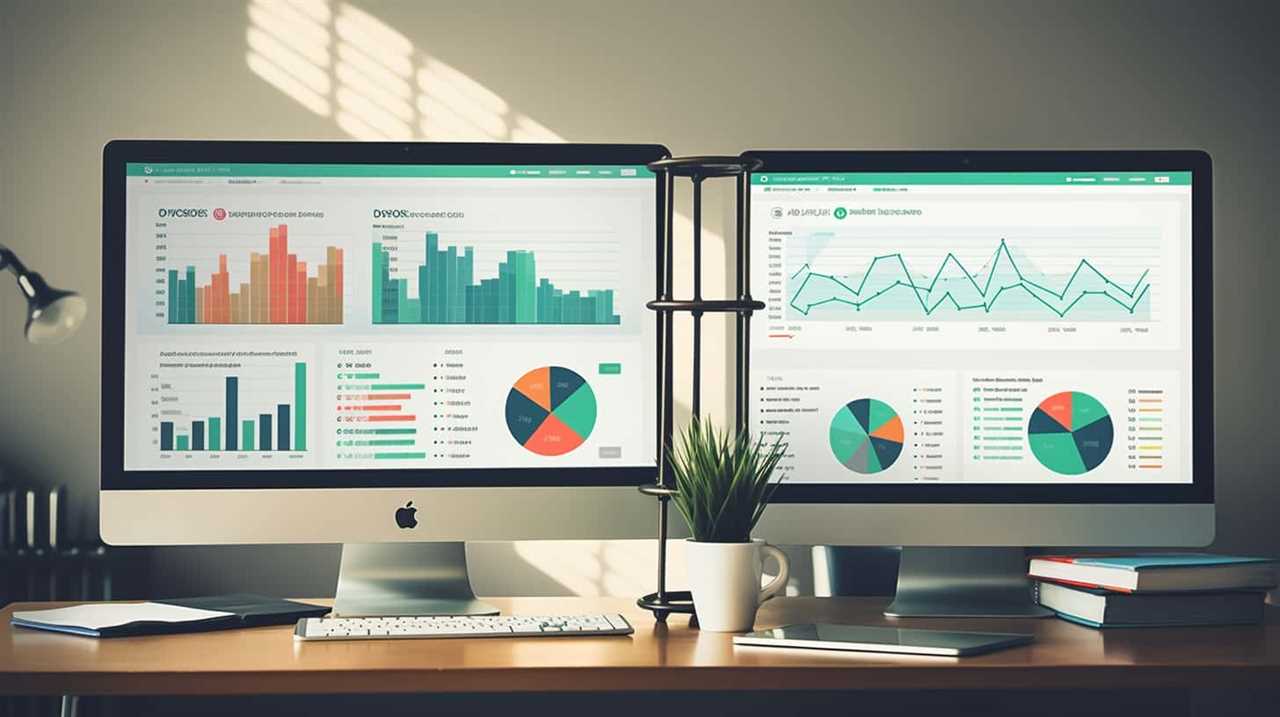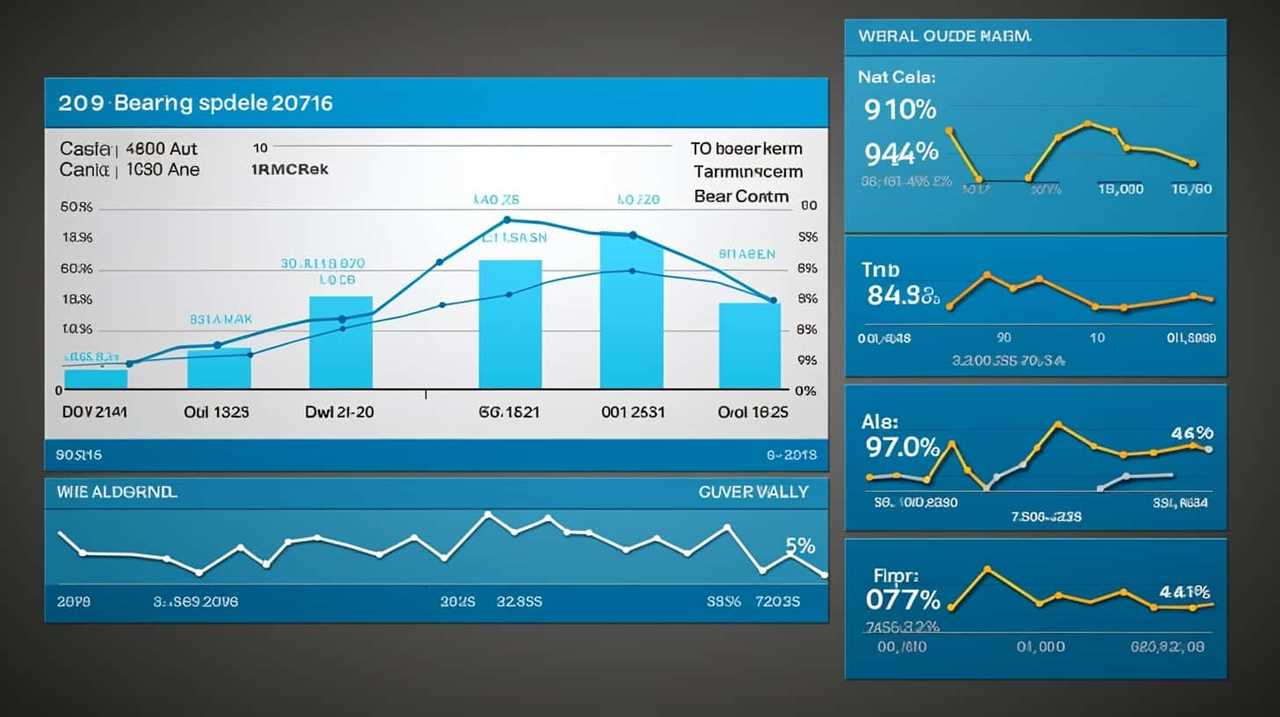Being passionate about sustainable living, I’ve always held the conviction that deeds are more impactful than declarations. This is why I’m thrilled to demonstrate the critical function that Google Ads can serve in enhancing an eco-friendly presence on the internet.
In this article, we’ll dive into the importance of Google Ads for sustainable living shops, how they work, and strategies for effective advertising.
Get ready to take your business to the next level and make a positive impact on our planet. Let’s harness the potential of Google Ads together!
Key Takeaways
- Google Ads can help sustainable living shops reach a wider audience and drive more traffic to their online store.
- By utilizing targeted campaigns and audience segmentation, sustainable living shops can overcome challenges in reaching their target audience.
- Creating engaging and relevant ad copies that resonate with the target audience is essential for driving action and promoting the benefits of sustainable living.
- Optimizing ad performance through careful management, tracking metrics, and regularly refining ad copy and keywords is crucial for growing a green presence online.
The Importance of Google Ads for Sustainable Living Shops
One key reason why Google Ads are crucial for sustainable living shops is that they allow me to reach a wider audience and drive more traffic to my online store. As a sustainable living shop owner, I’m passionate about promoting the benefits of sustainable living for individuals and the environment. However, I often face challenges in reaching my target audience. Many people are unaware of the numerous advantages that sustainable living can bring, both in terms of personal well-being and environmental conservation. This is where Google Ads come in.

By using Google Ads, I can create targeted campaigns that specifically reach individuals who are interested in sustainable living. These ads appear when people search for related keywords or browse websites that align with sustainable living values. By leveraging the power of Google’s vast reach and sophisticated targeting options, I can connect with a larger audience of potential customers who are actively seeking sustainable living products and solutions.
Not only do Google Ads help me reach a wider audience, but they also drive more traffic to my online store. When users click on my ads, they’re directed to my website, where they can explore the range of sustainable products I offer. This increased traffic not only boosts my online visibility but also increases the chances of converting visitors into customers.
Understanding Google Ads and how they work is essential for sustainable living shop owners like me. In the next section, we’ll delve deeper into the intricacies of Google Ads and learn how to maximize their potential for growing a green presence online.
Understanding Google Ads and How They Work
Understanding how Google Ads work is essential for sustainable living shops looking to grow their online presence. By targeting specific audiences, these ads can reach the right people who are interested in eco-friendly products and practices.

Additionally, by maximizing ad performance through techniques like keyword optimization and ad extensions, sustainable living shops can ensure that their ads are effective in driving traffic and conversions.
Targeting Specific Audiences
How can I effectively target specific audiences using Google Ads and understand how they work?
When it comes to reaching niche audiences with your online ads, Google Ads offers a range of effective targeting techniques. One of the most powerful tools at your disposal is the ability to target based on keywords and search terms. By selecting relevant keywords related to sustainable living and green products, you can ensure that your ads are shown to people actively searching for these topics.
Additionally, you can narrow down your audience by demographics, interests, and even specific locations. This level of precision allows you to reach the right people at the right time, increasing the chances of conversion and maximizing your ad performance.

Now, let’s delve into how you can further optimize your ads to get the best results.
Maximizing Ad Performance
What strategies can I employ to maximize my ad performance with Google Ads and gain a better understanding of how they work?
To maximize ad performance, it’s important to carefully manage and optimize your ad spend.
One strategy is to regularly review and analyze your ad performance metrics. By tracking metrics such as click-through rate (CTR), conversion rate, and cost per conversion, you can identify areas for improvement and make data-driven decisions.

Additionally, consider using ad extensions to provide additional information and enhance your ad’s visibility.
Experiment with different ad formats and targeting options to see what works best for your sustainable living shop.
Lastly, don’t forget to regularly test and refine your ad copy and keywords to ensure they align with your target audience’s needs and interests.
Identifying Your Target Audience for Effective Advertising
When and where should I focus my advertising efforts to effectively reach my target audience? It’s a question that every business owner asks themselves when it comes to advertising. The key to success lies in identifying your target audience and understanding their behavior and interests. To help you get started, here are some effective ad targeting strategies:

- Conduct market research: Understanding your target audience’s demographics, preferences, and purchasing behavior is crucial for effective advertising.
- Utilize audience segmentation: Divide your target audience into smaller groups based on common characteristics or interests. This allows you to create tailored ads that resonate with each specific segment.
- Analyze audience data: Take advantage of analytics tools to gain insights into your audience’s online behavior, such as their browsing habits, search keywords, and social media activity. This information can inform your ad targeting strategy.
- Use remarketing: Target users who’ve already shown interest in your products or services by retargeting them with personalized ads. This can help increase conversions and drive sales.
- Leverage social media platforms: Platforms like Facebook, Instagram, and LinkedIn offer advanced targeting options, allowing you to reach your desired audience based on factors like age, location, interests, and more.
Creating Engaging and Relevant Ad Copies
When it comes to creating engaging and relevant ad copies, the key is to craft impactful messages that resonate with your target audience.
By understanding the needs, interests, and values of your audience, you can tailor your ad copies to address their specific pain points or desires.
This not only captures their attention but also encourages them to take action and engage with your sustainable living shop.
Crafting Impactful Ad Copies
To effectively reach and engage potential customers, I focus on crafting impactful ad copies that are both engaging and relevant. Here are some ad copy optimization techniques that I employ to create persuasive ad messages:

- Captivating Headlines: I use attention-grabbing headlines that instantly draw the reader’s interest.
- Compelling Value Propositions: I highlight the unique benefits and value that our sustainable living products offer.
- Clear Call-to-Action: I provide a clear and concise call-to-action that prompts users to take the desired action.
- Emotional Appeal: I incorporate emotional language and storytelling to evoke a strong connection with the audience.
- Keyword Optimization: I strategically use relevant keywords to ensure our ads appear in relevant search results.
By implementing these techniques, our ad copies are able to effectively communicate our message, resonate with the audience, and drive conversions.
Now, let’s dive into the next section about targeting the right audience.
Targeting the Right Audience
How can I ensure that my ad copies effectively target the right audience and create engaging and relevant messaging? Effective audience segmentation is key when it comes to reaching eco-conscious consumers. By understanding the interests, values, and behaviors of your target audience, you can tailor your ad copies to resonate with them on a deeper level. One way to achieve this is by conducting market research to gather insights about your audience’s preferences and motivations. This information can then be used to create personalized ad copies that speak directly to their needs and desires. Additionally, incorporating relevant keywords and phrases in your ad copies can help increase visibility and attract the right audience. Here is an example of how you can structure your ad copies to effectively target eco-conscious consumers:
| Headline | Description |
|---|---|
| Go Green with Us | Discover sustainable products for a greener life |
| Eco-friendly Shopping | Shop consciously and make a positive impact |
| Sustainable Living | Find eco-friendly solutions for everyday living |
| Join the Green Movement | Support sustainable brands and protect the planet |
Selecting the Right Keywords for Your Ads
I frequently choose the perfect keywords for my ads to ensure maximum effectiveness. Selecting the right keywords is crucial for the success of your Google Ads campaign. Here are some tips on how to do it effectively:

- Ad campaign optimization: Optimize your ad campaign by selecting keywords that are relevant to your sustainable living shop. This will help you reach your target audience and increase your chances of conversion.
- Keyword research strategies: Conduct thorough keyword research to identify the most relevant and popular keywords in your industry. Use tools like Google Keyword Planner to find keywords with high search volume and low competition.
- Long-tail keywords: Focus on long-tail keywords that are more specific and have less competition. These keywords may have lower search volume, but they often lead to higher conversion rates.
- Negative keywords: Use negative keywords to exclude irrelevant searches and save your ad budget. For example, if you sell eco-friendly clothing, you can exclude terms like ‘fast fashion’ or ‘synthetic fabrics’ to ensure your ads are shown to the right audience.
- Regular keyword updates: Continuously monitor and update your keywords based on their performance. Remove underperforming keywords and add new ones to improve your ad campaign’s effectiveness.
Setting Up Conversion Tracking to Measure Success
Setting up conversion tracking is an essential step in measuring the success of your Google Ads campaign for sustainable living shops. By tracking conversions, you can determine how effective your ads are in driving desired actions, such as purchases, sign-ups, or downloads. This valuable data allows you to make informed decisions and optimize your campaign for better results.
To start measuring conversions, you need to set up conversion tracking in your Google Ads account. This involves placing a code snippet, called a conversion tag, on the page where the desired action takes place. For example, if you want to track purchases, the conversion tag should be placed on the order confirmation page. Once the tag is set up, Google Ads will track and record each conversion that occurs, providing you with valuable insights into the success of your campaign.
Measuring conversions goes beyond simply counting the number of actions taken. It also allows you to delve deeper into the data and analyze metrics such as conversion rate, cost per conversion, and return on ad spend. These metrics help you understand the effectiveness of your ads and make data-driven decisions to optimize your campaign for better performance.
Now that you have set up conversion tracking and are measuring conversions, it’s time to take it a step further and optimize your ads for mobile users.

Optimizing Your Ads for Mobile Users
Now that conversion tracking is in place, I can optimize my ads for mobile users to further enhance the success of my Google Ads campaign for sustainable living shops.
Mobile ad optimization is crucial in today’s digital landscape, where more and more people are using their smartphones to browse and shop online. By improving the user experience on mobile devices, I can increase the chances of attracting and converting potential customers.
Here are five key strategies for optimizing ads for mobile users:
- Responsive design: Ensuring that my ads are mobile-friendly and responsive will make them visually appealing and easily accessible on different screen sizes.
- Clear and concise messaging: Crafting concise and compelling ad copy that quickly grabs attention and conveys the value of sustainable living products.
- Call-to-action buttons: Including clear and prominent call-to-action buttons that guide mobile users towards taking the desired action, such as making a purchase or signing up for a newsletter.
- Fast loading speed: Optimizing my landing pages and ad elements to load quickly on mobile devices, as slow loading times can lead to user frustration and high bounce rates.
- Local targeting: Utilizing location targeting features to reach mobile users who are in close proximity to my sustainable living shops, increasing the chances of driving foot traffic.
Utilizing Ad Extensions to Enhance Your Ads
To enhance the success of my Google Ads campaign for sustainable living shops, I can utilize ad extensions to further optimize my ads for mobile users. Ad extensions are additional pieces of information that can be added to your ads to provide more value and improve their performance. By utilizing ad extensions, I can make my ads more compelling and increase their visibility on mobile devices, where most users are conducting their searches.

When it comes to ad extension best practices, there are a few key things to keep in mind. First, it’s important to choose the right extensions for your specific goals. For sustainable living shops, extensions like location extensions, call extensions, and sitelink extensions can be particularly effective. These extensions help users find your physical store, call your business directly, and navigate to specific pages on your website.
Measuring ad extension performance is crucial to understanding their impact on your campaigns. Google Ads provides detailed metrics that allow you to track the performance of your extensions, including click-through rates, impressions, and conversion rates. By analyzing this data, you can identify which extensions are driving the most engagement and adjust your strategy accordingly.
Monitoring and Analyzing Your Ad Performance
My ad’s performance can be monitored and analyzed by utilizing Google Ads’ detailed metrics. This allows me to gain valuable insights into how my ads are performing and make data-driven decisions to improve their effectiveness. Here are five ways I can leverage ad metrics to optimize my ad targeting and drive better results:
- Click-through Rate (CTR): By analyzing my CTR, I can measure how effective my ads are at capturing the attention of my target audience. If my CTR is low, I can experiment with different ad copy or visuals to increase engagement.
- Conversion Rate: Monitoring my conversion rate helps me understand how well my ads are converting viewers into customers. If my conversion rate is low, I can refine my targeting or landing page to improve the user experience and increase conversions.
- Cost per Conversion: Tracking my cost per conversion allows me to optimize my ad spend. If my cost per conversion is high, I can adjust my targeting or bidding strategy to reduce costs without sacrificing results.
- Ad Placement: Analyzing where my ads are being displayed can help me identify high-performing placements and allocate my budget accordingly. I can also exclude underperforming placements to improve overall campaign performance.
- Ad Scheduling: By analyzing when my ads are generating the most conversions, I can optimize my ad scheduling to maximize my ROI. I can increase bids or budget during peak times and decrease them during low-converting periods.
Scaling Your Google Ads Campaign for Long-term Success
As an advertiser for sustainable living shops, I can scale my Google Ads campaign to ensure long-term success by expanding my reach and maximizing my impact.

To achieve this, I need to employ effective scaling strategies and carefully measure my return on investment (ROI).
One scaling strategy is to increase my ad spend gradually. By starting with a modest budget and gradually increasing it as I see positive results, I can test the effectiveness of my ads and make necessary adjustments along the way. This allows me to find the optimal balance between reaching a wider audience and maintaining a positive ROI.
Another strategy is to expand my keyword targeting. By identifying additional relevant keywords and incorporating them into my ad campaigns, I can increase the chances of my ads being shown to potential customers who are actively searching for sustainable living products. This not only expands my reach but also improves the overall quality and relevance of my ads.
Measuring ROI is crucial for the long-term success of my Google Ads campaign. By closely monitoring key metrics such as click-through rates, conversion rates, and cost per acquisition, I can determine which ads and keywords are generating the most value for my business. This allows me to allocate my budget more effectively and optimize my ads for better performance.

Scaling my Google Ads campaign requires a strategic approach that focuses on expanding reach and maximizing impact. By implementing scaling strategies and measuring ROI, I can ensure long-term success for my sustainable living shop in the online marketplace.
Frequently Asked Questions
How Can I Optimize My Website for Better Conversion Rates?
To optimize my website for better conversion rates, I focus on website design and user experience. By keeping my site visually appealing, easy to navigate, and providing valuable content, I can engage and convert more visitors into customers.
What Are the Best Practices for Bidding on Keywords in Google Ads?
When it comes to bidding on keywords in Google Ads, the best practices involve maximizing ROI and implementing effective targeting strategies. It’s crucial to analyze search volume, competition, and relevance to ensure success.
How Can I Effectively Use Retargeting to Reach Potential Customers?
To effectively use retargeting, I segment my target audience based on their interests and behavior. By tailoring my ads to their specific needs, I can reach potential customers who have already shown interest in my sustainable living products.

What Are the Key Metrics to Track and Analyze in Google Ads?
When it comes to tracking and analyzing Google Ads, customer engagement and ad performance are key metrics. By monitoring click-through rates, conversion rates, and cost per acquisition, I can optimize my campaigns for maximum results.
How Can I Incorporate Sustainable Living Messaging Into My Ad Copies Effectively?
To effectively incorporate sustainable living messaging into ad copies, I focus on highlighting eco-friendly features, emphasizing the positive impact of the product or service, and using compelling language that resonates with environmentally conscious consumers.
Conclusion
In conclusion, utilizing Google Ads for sustainable living shops is crucial for growing a green presence online.
By understanding how Google Ads work and identifying your target audience, you can create engaging ad copies and select the right keywords to effectively reach potential customers.

Optimizing your ads for mobile users and utilizing ad extensions will further enhance your advertising efforts.
By monitoring and analyzing your ad performance, you can scale your Google Ads campaign for long-term success.
So, don’t miss out on the opportunity to make a positive impact and promote sustainable living through online advertising.










